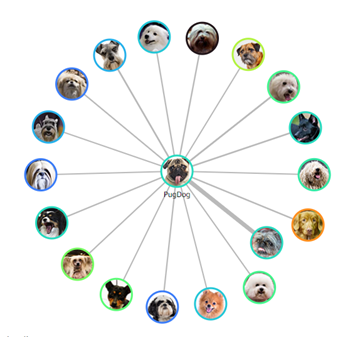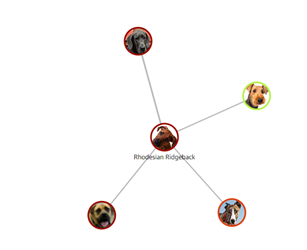The Relatedness of Breeds - A fun, interactive resource with some cautions
The Relatedness of Breeds - A fun, interactive resource with some cautions
...see references below...
The Guardian has come out with an interactive tool for looking a the relatedness between breeds. Based on 'clades' (genetic groupings) research and genomic work by by Heidi Parker and Elaine Ostrander's team, it is an interesting resource. Click on your breed - see what others breeds it is related to. Fun!
But there are a couple of cautions that apply:
-
 This is great work - but the relatedness has changed to some extent with each new edition of the research, with the advancement of techniques, so this is not written in stone.
This is great work - but the relatedness has changed to some extent with each new edition of the research, with the advancement of techniques, so this is not written in stone.
- Using gene patterns to determine relatedness is just that - it does not say that another breed was part of the development of your breed - or whether your breed has been used to develop the other one. They are simply 'related'.
- Difference in relatedness may be seen depending on how 'old' your breed is. Relationships that have occurred more recently may show up as stronger.
- This should not be confused with commercial tests that tell you the breed composition of your mixed breed dog. This is different technology and looks primarily at 'pedigree' dogs. To learn more about mixed breed testing see recent blogs: Ask Aimee: Can my dog's ancestry test tell me who its parents are? and HGTD This week: Guess my dog! Are breed/type genetic tests right for you?
- This is, however, a good reminder that what some people call 'purebred' dogs - what we generally call pedigree dogs (listed in an official registry as a specific breed) are not really 'pure'. Which is likely a good thing! A breed can approach 'pure' only through heavy inbreeding that leads to all sorts of other problems.
 On the other hand, the work to assign dogs to related clades and to determine relationships among breeds is beneficial in terms of:
On the other hand, the work to assign dogs to related clades and to determine relationships among breeds is beneficial in terms of:
- It is simply interesting and informative.
- It may provide food for thought when selecting breeds for out-crosses when trying to improve the genetic diversity within a breed. This can go both ways, i.e. it is nice to find already related breeds, but using a breed closely related may not increase the diversity that much. And, as seen in our outtakes - the number of related breeds varies quite a lot.
- Expanding on comments by Dr. Ostrander... This type of research could have a lot of value to dog breeds (and other species) by having a deeper understanding of the genetic differences between breeds/varieties of dogs. Identifying these genetic differences may be fundamental to furthering research into many aspects of canine health and welfare - from better investigations of complex disease, to improving longevity and genetic diversity.
Anyway, check it out!
References:
- Interactive: see how your favourite dog breeds are related to each other in The Guardian.
-
Genomic Analyses Reveal the Influence of Geographic Origin, Migration, and Hybridization on Modern Dog Breed Development authors Heidi G. Parker, Dayna L. Dreger,
Elaine A. Ostrander, the National Human Genome Research Institute. 2017.
 Donate
Donate
 This is great work - but the relatedness has changed to some extent with each new edition of the research, with the advancement of techniques, so this is not written in stone.
This is great work - but the relatedness has changed to some extent with each new edition of the research, with the advancement of techniques, so this is not written in stone.
1 Comment
Recommended Comments